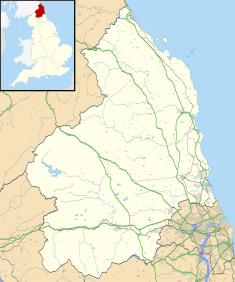Wallington is a country house and gardens located about 12 miles (19 km) west of Morpeth, Northumberland, England, near the village of Cambo. It has been owned by the National Trust since 1942, after it was donated complete with the estate and farms by Sir Charles Philips Trevelyan, the first donation of its kind. It is a Grade I listed building.[1] Some of the wealth of the Trevelyan family derived from the holding of slaves in Grenada.[2]
| Wallington Hall | |
|---|---|
 | |
| Type | Country house |
| Location | Cambo |
| Coordinates | 55°09′07″N 1°57′25″W / 55.152°N 1.957°W |
| OS grid reference | NZ 02880 84191 |
| Area | Northumberland |
| Built | 1688 |
| Rebuilt | 1735–1745 |
| Architect | Daniel Garret |
| Architectural style(s) | Palladian |
| Owner | National Trust |
Listed Building – Grade I | |
| Official name | Wallington Hall |
| Designated | 6 May 1952 |
| Reference no. | 1042869 |
History edit
The estate was owned by the Fenwick family from 1475 until Sir John Fenwick, 3rd Baronet had financial problems and opted to sell his properties to the Blacketts in 1688. He sold the rump of the family estates and Wallington Hall to Sir William Blackett for £4000 and an annuity of £2000 a year. The annuity was to be paid for his lifetime and that of his wife, Mary Fenwick. Blackett was happy with the deal as he discovered lead on the land and he became rich.[3]
The hall house was rebuilt, demolishing the ancient pele tower, although the cellars of the early medieval house remain.[4] The house was substantially rebuilt again, in Palladian style, for Sir Walter Blackett by architect Daniel Garret, before passing to the Trevelyan family in 1777.
After Pauline Jermyn married the naturalist Sir Walter Calverley Trevelyan, they began hosting literary and scientific figures at the Hall.[5] As a cultural centre, Wallington visitors included members of the Pre-Raphaelite Brotherhood.
Sir Charles Philips Trevelyan inherited the property from his father, Sir George Otto Trevelyan, in 1928. He was a leading member of Liberal and Labour governments in the late 1920s. Charles was married to "Molly", Lady Mary Trevelyan.[6]
Description edit
This section needs additional citations for verification. (November 2023) |
The house is set in 100 acres (40 ha) of rolling parkland, which includes a wooded dene (valley), ornamental lakes, lawns, and a recently refurbished walled garden.
The ceilings in the dining and drawing rooms are decorated in the rococo style by the Italian artist, Pietro Lafranchini . Attractions inside the house include the desk where Thomas Babington Macaulay, brother-in-law of Sir Charles Trevelyan, wrote his History of England, a large collection of antique dollshouses,[7] and eight murals in the central hall depicting the history of Northumberland, painted by William Bell Scott.[1]
The National Trust also own the estate of which the house is a part; the produce from these farms, as well as others in the region, was sold in a farm shop on site. The farm shop closed in 2012.
Wildlife edit
In July 2023, a family of beavers was released in a 24 ha (59 acres) enclosure on a tributary of the Hart Burn in the centre of the estate. This is the third release of beavers at a National Trust property.[8]
In November 2023, The Martens on the Move project announced it was introducing pine martens to the 5,231 ha (12,930 acres) estate in an effort to reestablish the animals in England. The project is facilitated by a £1.2 million grant from the National Lottery Heritage Fund.[9]
These initiatives are part of a long term project, called Wilder Wallington, to reintroduce native species of plants and animals to the estate and to encourage the restoring of peat and wetlands and other nature recovery schemes. One aim is to plant one million trees by 2030, some 115,000 have already been planted. Other animals being considered for reintroduction are water voles[10]
See also edit
References edit
- ^ a b Historic England. "Wallington Hall (1042869)". National Heritage List for England. Retrieved 9 September 2018.
- ^ "Britain's Idyllic Country Houses Reveal a Darker History". The New Yorker. 13 August 2021.
- ^ "BLACKETT, Sir William, 1st Bt. (1657-1705), of Greyfriars House, Newcastle-upon-Tyne and Wallington Hall, Northumb. | History of Parliament Online". www.historyofparliamentonline.org. Retrieved 6 May 2021.
- ^ "The Blacketts and the building of Wallington". National Trust. Retrieved 6 May 2021.
- ^ Bonney, Thomas George (1897). . In Lee, Sidney (ed.). Dictionary of National Biography. Vol. 52. London: Smith, Elder & Co.
- ^ "Trevelyan [née Bell], Mary Katharine [Molly], Lady Trevelyan (1881–1966), political hostess and voluntary worker". Oxford Dictionary of National Biography (online ed.). Oxford University Press. 2004. doi:10.1093/ref:odnb/53939. ISBN 978-0-19-861412-8. Retrieved 4 May 2021. (Subscription or UK public library membership required.)
- ^ "Things to see and do in the house at Wallington". National Trust. Retrieved 14 November 2023.
- ^ "Beaver reintroduction at Wallington". National Trust. Retrieved 14 November 2023.
- ^ "Pine martens reintroduced at Northumberland's Wallington estate". BBC News. Retrieved 14 November 2023.
- ^ "Wilder Wallington". National Trust. Retrieved 14 November 2023.
External links edit
Further reading edit
- Kirtley, Allan, Longbottom, Patricia, Blackett, Martin (6 August 2023). A History of the Blacketts. (2013) The Blacketts. ISBN 978-0-9575675-0-4. Archived from the original on 23 June 2014.
{{cite book}}: CS1 maint: multiple names: authors list (link) - Moran, Mollie. Minding the Manor: the Memoir of a 1930s English Kitchen Maid. 2014, Lyons Press. First published in the UK in 2013 as Aprons and Silver Spoons by Penguin Books.
